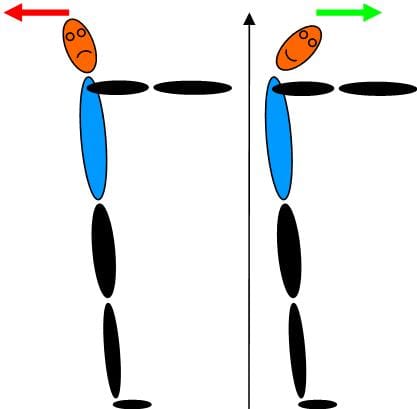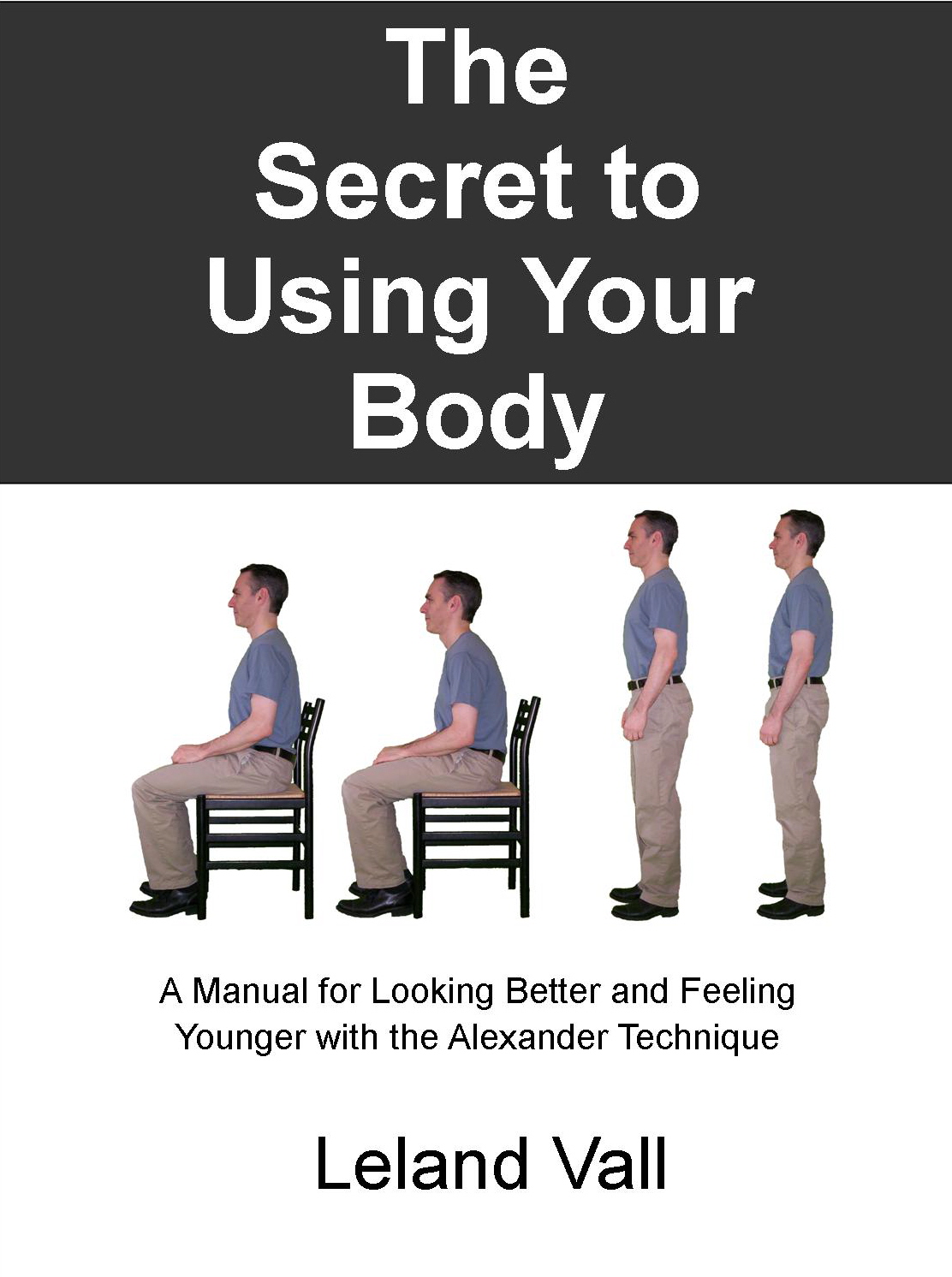For improved balance, reduce neck tension.
New students often ask, “where should I put my head?” In fact, there is no proper position for your head because your head moves in response to everything you do. As shown in the image above, the free movement of your head contributes to balance because its weight at the top of your spine counterbalances your torso. Neck tension limits head movement and your ability to respond to balance challenges. And if you ever feel like your are falling backwards, put your head forward, not back.
Resources for Improving Balance:
Balance and the Alexander Technique
Video & Article: Walk with More Stability and Power
Extra:
For Josh Pence, the Alexander Technique, “…paid off in spades”.
There are more resources available on the Free Your Neck Blog. Please write your requests in the comment section.




Hey Leland, Thank you very much for that detailed, carefully-thought out, and admirably articulated response! I’m very glad I asked, since it elicited such a fountain of wisdom. (I’m not flattering you, just expressing how I feel.) Is this a valid statement: When you say the head responds to everything we do, you mean something like, “The head has to find new ways of staying free on a loose neck (thereby allowing the head to move forward and up), for every new activity or position. In that sense, the head responds to every new movement or position. But the act of the head moving forward and up is actually best thought of as a kind of leading edge of all movements.”
Hi Robb,
I would says that isn’t right at all. I liked your first question and it got me thinking, but remember that this blog is just a list of “tips”, there are no real answers here. I would suggest finding the tip or tips that really speak to you and don’t worry about the one’s that don’t make sense. Maybe it’s just not a good tip. And also, talking about the Alexander Technique doesn’t really get you anywhere, you need to have the experience. If you really want to find answers, find an Alexander teacher and take some lessons.
Leland
If you have a moment to clear up a confusion in my mind…you say the “head should be available to move in response to anything you do,” but that seems to contradict the idea of the head leading all movement. Could you shed some light on the paradox? Thanks! –Robb
Hi Rob,
Thanks, that’s an interesting question.
As one allows the neck to be more free, the head tends to move forward and up in relation to the spine. One could also say that the release of the head forward and up is the head leading. Conscious movement with appropriate tension and clarity does not interfere with the release of the head because the head can always be allowed to release from it’s place, no matter where it is or where it is moving. Of course the head is generally always moving, but at the same time there is also always opportunity to allow for more release of the neck and head. Think of smooth clear movement or comportment, or graceful movement with power and speed. To the degree that the head and neck are releasing, new decisions about movement should be available even during vigorous activity.
The problem comes when before movement starts, even with just with the first response to a stimulus to move, most people tend to pull the head down and back, increasing the tension between the head and neck. This is part of the pattern of being. The neck is always tending toward tension, and then it becomes more tense as energy rises with movement or any response to a stimulus. When that happens it becomes difficult to move the head because it is already busy being held as part of the pattern of the larger movement or response.
In short, I’m looking for less tension between the head and neck. To the degree that one is allowing the neck to be free so that the head can go forward and up, that is how much the head will lead. The head is generally always moving, the release has to happen within the movement and during the stimulus to move. If there is too much tension, conscious movement of the head or a change of movement won’t generally be possible in that moment.
I hope that answers your question.
Leland
These tips always help me, Leland.
what is an indirect approach of f.m.Alexander?
ans @
i noticed head back and down, what i have to do?
ans@ don’t do directly with the head. first do with the neck indirectly then do the head forward.
i noticed my pelvis slumped , what i have to do?
ans@ don’t make the right thing of the pelvis to make it not slump,
first indirectly do with the neck to let the head forward,
then send the knees too much forward indirectly, to let the pelvis not slump.
what are others?
What is primary control?
Ans@ head -neck-back relationship.
OR
head-torso relationship.
With stimulus of walk,sit,bend
‘free the neck to let the head go forward and up and back lengthen and widen’
…..
Let the neck be free
to let the head go forward and up
to let the back lengthen and widen
to let the limbs release away from torso.
….
…..
Let the neck be free
let the head go forward and up
let the back lengthen and widen
let the limbs release away from torso.
…..
whether diaphram , which is an involuntary part getting most of the support from head,neck, thoratic curve( ribcage)?
FLAVORS OR TYPES OF THE SLUMP :
——————————-
torso has 1) neck 2) thoratic spine 3) ribcage 4) lumbar spine 5) pelvis with sitting bones and hip joints.
there are suppose total 5 sub parts are there in the TORSO(BACK) main part:::
** these parts can be arranged in almost 20 to 25 combinations.
part1(neck) part2(thoratic spine) part3 part4 part5 Result
———- ——————— —– —– —– ——-
alexDirection – misdirection – mis – mis – mis misdirection
misdirection – alex direction – mis – mis – mis misdirection
misdirection – misdirection – alex dire – mis – mis misdirection
.
.
.
.
.
.
.
alex direction- alexdirect- alexdirect- alex dire-alex ALEXDIRECTION
out of 25 combinations of the five parts::
alexander ‘BAKC LENGTHEN AND WIDEN with back going back with stimuls’
is the most(best) satisfactory direction and least energy usable direction.
so the flavors and type of the slumps may be almost 25 types.
what type of the slump i have?
what part i lost in the back lengthen and widen parts?
now what type of the slump iam moving with?
i dont want to do the right thing, iam just in this type of slump now, i have choice in the next movement?
—-
this plan may works for me…
if we not stoop or poke the ‘thoratic spine’ forward, then
while moving forward from the hip joints and sitbones ( with sitting)
then,
the neck goes up ,the head goes forward and up, and the lumbar spine goes up and the pelvis goes up then totally UP, releasing the knees forward and feet to ground and arms with shoulders release ,one after the other alltogether.
what is the meaning of ‘UP’?
ans :: ‘NOT DOWN’ or ‘NOT STOOP’
so, if the ‘thoratic curve’ is ‘NOT DOWN(no stooping)’direction, then it is in towards ‘UP ‘ direction.
if the ‘thoratic curve’ is in ‘UP’ direction, then nothing we can do. since, it is already in UP direction.
1) there is no need to do more ‘UP’
2) there is no need to do most ‘UP’
3) there is need to do less ‘UP’ or simply ‘UP’ .
God given us neck to use in combination with head,torso. BUT, not to misuse in combination with head,torso.
” I see atlast that if I don’t breath , I breath” – F.M.Alexander
the above statement told by alexander.
Iam NONDOING for to make the neck tension satisfactory.
iam DOING for to male the neck tension satisfactory.
Iam NONDOING for to make the neck tension satisfactory.
iam DOING for to make the neck tension satisfactory.
What is the best position OR posture in the world?
A person while swimming, what is the best posture?
Ans@ if a person swimming maintains the best posture, he can’t swim or grow.
If we take a vedio of 2 minutes while he is swimming, that vedio has almost 2000 snaps.
What is the best posture out of 2000 snaps.
Or
2000 snaps are best postures?
This is a unreasonable thought.
But, the swimmer is having directions for neck,head,torso,limbs,eyes parts.
So, we can think the legs can be released in any direction away from torso in any direction either left, right etc.
Again if he releases left side only while swimming he cant swim or grow.
The same thing applies to hands.
If he swims thinking alex directions of good use, he gets some thing satisfactory swim .
I liked the word neck tension limits the head movement.
But,
why the neck tenses,
ans@ the torso tenses
but,
why the torso tenses
ans@ by limbs, neck directly and indirectly by head.
Notice, the alexander lecture in the above comments@
……
When the head is put forward, the body is pulled back
when the head is pulled backward, the body is put forward.
That is the way the primary control usually works.
These statements are declared by alexander, in the presence of audience.
Who declared the ‘primary control ‘ is a head-neck-back relation ship?
Wether alexander declared primary control related to head-neck-back relationship?
Or
head-torso relationship?
what is neck?
neck is a part of torso.
what is pelvis?
pelvis is a part of torso.
what are sitting bones?
sitting bones are part of torso.
what is the ribcage?
ribcage is a part of torso.
WHAT IS NECK?
NECK IS A PART OF TORSO.
in a lecture alexander told the below statements and explained to the audience:
=======================================================================f that chin had not pulled in the least little bit we should not have lost the direction again. Now watch again.
(To the student) Now we have got the whole thing clear in our brain. We are simply going to send the message from the brain to let the head go forward and the knees forward and the hips back. Now we are not going to let the head go back and we are going to put the knees forward a little more. We have not to bother about our breathing. Our ribs are moving perfectly.
What this young lady is doing now is a very difficult thing to do. She is directing her head forward from here. (Now Mr Alexander indicated with his hand a part of her back) her knees forward and her hips back, and that is the only way you can get your antagonistic pulls. By physical culture methods you do not get antagonistic pulls, and that is what is the matter.
The working is all antagonistic. When the head is put forward, the body is pulled back; when the head is pulled back, the body is put forward. That’s the way the primary control usually works.
so, the torso always goes back and the head goes forward and up and knees goes forward
while the hips going back.
So if she will not try to do something, but instead leaves herself in my hands and simply remembers she has not to pull her head back you will see that back widening and lengthening in the next four or six hours.
A has direct relation ship with B
B has direct relation ship with C
C has direct relation ship with D
then A has indirect relation ship with D.
—————————————-
the abdomen gets its direct power from the thorax
the thorax gets its direct power from the neck
the neck gets its direct power from the head
then the abdomen gets its indirect power from the head
( based on the above A,B,C,D releationships)
And if you ever feel like your are falling backwards, put your head forward, not back.
this is good statement by leland val:::
based on the above statement
if i think , if i ever feel falling forwards, shall i put my head back?
how this works for me?
what is neck?
ans :
1)neck is the human part between head and torso.
2)neck has four sides
front of the neck
left side of the neck
right side of the neck
BACK of the neck
3) the back of the neck has extensor muslces,
and the front of the neck has flexor muscles.
4) if the neck is free , then the it goes up balancing the flexor and extensor muscles
5) thinking only the back of the muscles means, for getting the front and sides of the neck muscles
alexander never told back of the neck, he told the total neck.
the alexander statement of ::::::
LET THE NECK BE FREE,
in the above statement he is clearly stating the total neck , but he is not specifically stating the back of the neck.
so, the total neck thinking is desirable , i think and it is better to my opinion.